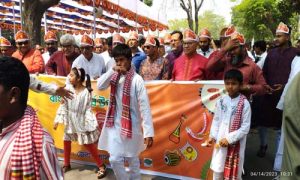
PahelaBaishakh, the 1st day of Bengali New Year-1430, has been observed in Kurigram district in befitting manner on April 14.
People of all walks of live including administration and students of various educational institutes were gathered at “SadhinatarBijoyStambho” in Kurigram outer stadium at 10am.
At first the National anthem was presented by the artists of KurigramShilpokala Academy led by general secretary of the ShilpokalaAcademy,Shishu Academy, principal RasheduzzamanBabu. At the end of national anthem the Baishakhi song written by Rabindranath Tagor“EshoEsho Hey Boishakh,EshoEsho” was also presented.
Then Mongol Shovajatra(Rally) was brought outto Shapla squarewith tight security carrying colorful banner, mask, festoons and band party of Bangladesh Police with DC Mohammad SaidulArif,SP AlAsad Mohammad Mahfujul Islam, Mayor of Kurigram municipality Kaziul Islam,Civil Surgeon Dr. Mohammad Monjur –e Morshed,principal of Kurigram Law college ,Public prosecutor and eminent lawyer Advocate Abraham Lincoln,BirProtik Abdul Hye,local elites,government and non -government officers of various offices, reporters, political leaders and different social and cultural activists were participated there.
But, due to the ongoing holy month of Ramadan, it was celebrated on a limited scale. No Panthabhath,patshakh,Shutky and Hilsha fish was eaten as all the Muslim devotees as performing Roza.However same programs were also held in all the upazila in the district.
PahelaBaishakh is one of the most colorful festivals through which the Bengalis bid farewell to the old year and welcome the New Year. On this occasion, people from all walks of life wear traditional Bengali dresses.
Young women wear white sarees with red borders and some school girl and college girls also wear red color shariadorn themselves with bangles, flowers, and tips, while men wear white pyjamas and Panjabi in red and yellow color.
However, business communities, openedtheir traditional ‘Halkhata’, new account books. On the day traders were also offering sweets to customers.
Improved traditional food distributed to jail inmates, patients in hospitals and orphanages on the occasion.
Some historians attribute the Bengali calendar to the 7th-century king Shashanka, which was later modified by the Mughal emperor Akbar for the purpose of tax collection.